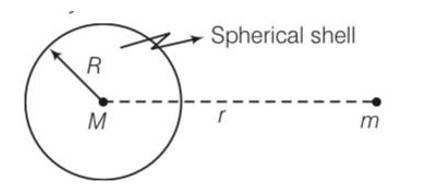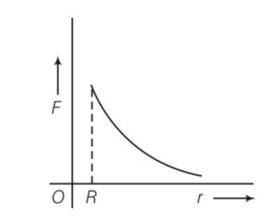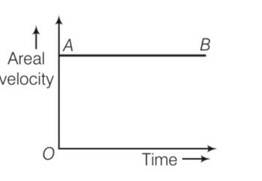Physics NCERT Exemplar Solutions Class 11th Chapter Eight
Get insights from 134 questions on Physics NCERT Exemplar Solutions Class 11th Chapter Eight, answered by students, alumni, and experts. You may also ask and answer any question you like about Physics NCERT Exemplar Solutions Class 11th Chapter Eight
Follow Ask QuestionQuestions
Discussions
Active Users
Followers
New answer posted
5 months agoContributor-Level 10
This is a Short Answer Type Questions as classified in NCERT Exemplar
Explanation- As density of the shell is constant

So mass of shell = density (volume)
=
If we consider shell is uniform so F=gravitational force =GMm/r2
F=0 for r
= GM/r2 for r>R

Variation of f verses r
New answer posted
5 months agoContributor-Level 10
This is a Short Answer Type Questions as classified in NCERT Exemplar
Explanation- Inside a small spaceship orbiting around the earth, the value of acceleration due to gravity can be calculated as constant and hence astronaut feels weightlessness.
If the space station orbiting around the earth has a large size such that variation in g matters in that case astronaut inside the spaceship will experience gravitational force and hence can detect gravity.
New answer posted
5 months agoContributor-Level 10
Explanation- A body can be shielded from the gravitational influence of nearby matter because gravitational force between two point mass bodies is independent of the intervening medium. we cannot shield a body from gravitational influence of nearby matter.
New answer posted
5 months agoContributor-Level 10
This is a Short Answer Type Questions as classified in NCERT Exemplar
Explanation- Yes, a body can have inertia but no weight. When we taken body to the centre of earth its has some inertia but no weight .

New answer posted
5 months agoContributor-Level 10
This is a Short Answer Type Questions as classified in NCERT Exemplar
Explanation- Gravitational forces acting between two point masses m1 and m2, F= Gm1m2/r2 is independent of nature between them. So the gravitational force will remain unaffected when dipped in water.
New answer posted
5 months agoContributor-Level 10
This is a Short Answer Type Questions as classified in NCERT Exemplar
Explanation-areal velocity of earth and sun
dA/dt=L/2m
where L is angular momentum
but we know L= r
dA/dt=1/2m (r )=1/2 (r )
so dA/dt direction will be perpendicular to the plane containing r and v
New answer posted
5 months agoContributor-Level 10
This is a Short Answer Type Questions as classified in NCERT Exemplar
Explanation-

areal velocity of a planet revolving around the sun is constant with respect to time.
New answer posted
5 months agoContributor-Level 10
Explanation- examples of central force – gravitational force and electrostatic force
Examples of non central force = nuclear force, magnetic force acting between two current carrying loops etc.
New answer posted
5 months agoContributor-Level 10
This is a Short Answer Type Questions as classified in NCERT Exemplar
Explanation-air molecules in the atmosphere are attracted vertically downward by the gravitational force of the earth just like an apple falling from the tree. Air molecules move randomly due to their thermal velocity and hence resultant motion of air molecules move randomly in vertical downward direction. But in case of apple it is heavier than air so it fall downwards only.
New answer posted
5 months agoContributor-Level 10
This is a Long Type Questions as classified in NCERT Exemplar
Explanation- rp= radius of perihelion =2R
Ra = radius of aphelion =6R
So ra=a(1+e)=6R
And rp= a(1-e)=2R
Solving above eqns
We get e = ½
By conservation of angular momentum angular momentum at perigee= angular momentum at apogee
So mvprp=mvara
Va/vp=1/3
Where m is mass of satellite .
By conservation of energy , energy at perigee =energy at apogee
-
So
Vp= =
Vp=6.85km/s , va=2.28km/s
So orbital velocity vc=
R=6R ,vc= 3.23km/s
Hence to transfer to a circular orbit at apogee , we have to boost the velocity by 3.23-2.28=0.95km/s.
Taking an Exam? Selecting a College?
Get authentic answers from experts, students and alumni that you won't find anywhere else
Sign Up on ShikshaOn Shiksha, get access to
- 65k Colleges
- 1.2k Exams
- 679k Reviews
- 1800k Answers
